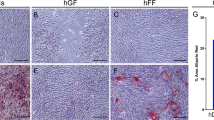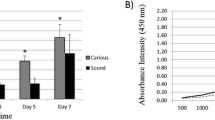Abstract
Objectives
This study aimed to differentiate and characterize fibroblast-like cells from stem cells from human exfoliated deciduous teeth (SHED).
Materials and methods
The differentiation of fibroblast-like cells from SHED was carried out by using specific human recombinant connective tissue growth factor (CTGF). To characterize fibroblastic differentiation, the induced cells were subjected to morphological changes, proliferation rate, gene expression analysis using quantitative reverse transcription-polymerase chain reaction (qRT-PCR), flow cytometry, and immunofluorescence staining. The commercial primary human gingival fibroblasts served as positive control in this study.
Results
The results from characterization analysis were compared with that of commercial cells to ensure that the cells differentiated from SHED were fibroblast-like cells. The results showed the inductive effect of CTGF for fibroblastic differentiation in SHED. SHED-derived fibroblasts were successfully characterized despite having similar morphological appearance, i.e., (i) significant proliferation rate between fibroblast-like cells and SHED, (ii) high expression of fibroblast-associated markers in qRT-PCR analysis, and (iii) positive staining against collagen type 1, fibroblast-specific protein 1, and human thymic fibroblasts in flow cytometry analysis and immunofluorescence staining. The same expression patterns were found in primary human gingival fibroblasts, respectively. SHED as negative control showed lower expression or no signal, thus confirming the cells differentiated from SHED were fibroblast-like cells.
Conclusions
Taken together, the protocol adopted in this study suggests CTGF to be an appropriate inducer in the differentiation of SHED into fibroblast-like cells.
Clinical relevance
The fibroblast-like cells differentiated from SHED could be used in future in vitro and in vivo dental tissue regeneration studies as well as in clinical applications where these cells are needed.




Similar content being viewed by others

References
Tomasek JJ, Gabbiani G, Hinz B, Chaponnier C, Brown RA (2002) Myofibroblasts and mechano-regulation of connective tissue remodeling. Nat Rev Mol Cell Biol 3:349–363
Mohd Nor NH, Berahim Z, Azlina A, Mokhtar KI, Kannan TP (2017) Identification and characterization of intraoral and dermal fibroblasts revisited. Curr Stem Cell Res Ther 12:675–681
Häkkinen L, Larjava H, Fournier BP (2014) Distinct phenotype and therapeutic potential of gingival fibroblasts. Cytotherapy 16:1171–1186
Enoch S, Wall I, Peake M, Davies L, Farrier J, Giles P, Baird D, Kipling D, Price P, Moseley R, Thomas D, Stephens P (2009) Increased oral fibroblast lifespan is telomerase-independent. J Dent Res 88:916–921
Irwin CR, Picardo M, Ellis I, Sloan P, Grey A, McGurk M, Schor SL (1994) Inter-and intra-site heterogeneity in the expression of fetal-like phenotypic characteristics by gingival fibroblasts: potential significance for wound healing. J Cell Sci 107:1333–1346
Stephens P, Davies KJ, Al-Khateeb T, Shepherd JP, Thomas DW (1996) A comparison of the ability of intra-oral and extra-oral fibroblasts to stimulate extracellular matrix reorganization in a model of wound contraction. J Dent Res 75:1358–1364
Sloan P (1991) Current concepts of the role of fibroblasts and extracellular matrix in wound healing and their relevance to oral implantology. J Dent 19:107–109
Lee HG, Eun HC (1999) Differences between fibroblasts cultured from oral mucosa and normal skin: implication to wound healing. J Dermatol Sci 21:176–182
Driskell RR, Watt FM (2015) Understanding fibroblast heterogeneity in the skin. Trends Cell Biol 25:92–99
Saintigny G, Bonnard M, Damour O, Collombel C (1993) Reconstruction of epidermis on a chitosan cross-linked collagen-GAG lattice: effect of fibroblasts. Acta Derm Venereol 73:175–180
Moharamzadeh K, Brook IM, Van Noort R, Scutt AM, Thornhill MH (2007) Tissue-engineered oral mucosa: a review of the scientific literature. J Dent Res 86:115–124
Fusenig NE (1994) Epithelial-mesenchymal interactions control keratinocyte growth and differentiation in vitro. The keratinocytes handbook. Cambridge University Press, Cambridge, pp 71–94
Smola H, Stark HJ, Thiekötter G, Mirancea N, Krieg T, Fusenig NE (1998) Dynamics of basement membrane formation by keratinocyte–fibroblast interactions in organotypic skin culture. Exp Cell Res 239:399–410
Liu J, Mao JJ, Chen L (2010) Epithelial–mesenchymal interactions as a working concept for oral mucosa regeneration. Tissue Eng B Rev 17:25–31
Dannan A (2009) Dental-derived stem cells and whole tooth regeneration: an overview. J Clin Med Res 1:63–71
Yamamura T (1985) Differentiation of pulpal cells and inductive influences of various matrices with reference to pulpal wound healing. J Dent Res 64:530–540
Miura M, Gronthos S, Zhao M, Lu B, Fisher LW, Robey PG, Shi S (2003) SHED: stem cells from human exfoliated deciduous teeth. Proc Natl Acad Sci 100:5807–5812
Lee C, Moioli E, Mao J (2006) Fibroblastic differentiation of human mesenchymal stem cells using connective tissue growth factor. Int Conf Proc IEEE Eng Med Biol Soc 1:775–778
Gazarian KG, Ramírez-García LR (2007) Human deciduous teeth stem cells (SHED) display neural crest signature characters. PLoS One 12:e0170321
Ma L, Makino Y, Yamaza H, Akiyama K, Hoshino Y, Song G, Kukita T, Nonaka K, Shi S, Yamaza T (2012) Cryopreserved dental pulp tissues of exfoliated deciduous teeth is a feasible stem cell resource for regenerative medicine. PLoS One 7:e51777
Zhang N, Chen B, Wang W, Chen C, Kang J, Deng SQ, Zhang B, Liu S, Han F (2016) Isolation, characterization and multi-lineage differentiation of stem cells from human exfoliated deciduous teeth. Mol Med Rep 14:95–102
Tong Z, Sant S, Khademhosseini A, Jia X (2011) Controlling the fibroblastic differentiation of mesenchymal stem cells via the combination of fibrous scaffolds and connective tissue growth factor. Tissue Eng A 17:773–2785
Abiko Y, Hiratsuka K, Kiyama-Kishikawa M, Tsushima K, Ohta M, Sasahara H (2004) Profiling of differentially expressed genes in human gingival epithelial cells and fibroblasts by DNA microarray. J Oral Sci 46:19–24
Aikawa T, Gunn J, Spong SM, Kalus SJ, Korc M (2006) Connective tissue growth factor-specific antibody attenuates tumor growth, metastasis, and angiogenesis in an orthotopic mouse model of pancreatic cancer. Mol Cancer Ther 5:1108–1116
Kalluri R, Zeisberg M (2006) Fibroblast in cancer. Cancer 6:392–401
Funding
This paper was supported by Universiti Sains Malaysia Research University Grant (1001/PPSG/812168) and Malaysia Toray Science Foundation (MTSF) Research Grant (Toray Science Foundation, Japan) (304/PPSG/6150150/M126).
Author information
Authors and Affiliations
Corresponding author
Ethics declarations
Conflict of interest
The authors declare that they have no conflict of interest.
Ethical approval
This article does not contain any studies with human participants or animals performed by any of the authors.
Informed consent
For this type of study, formal consent is not required.
Additional information
Publisher’s note
Springer Nature remains neutral with regard to jurisdictional claims in published maps and institutional affiliations.
Rights and permissions
About this article
Cite this article
Mohd Nor, N.H., Berahim, Z., Azlina, A. et al. Identification of novel fibroblast-like cells from stem cells from human exfoliated deciduous teeth. Clin Oral Invest 23, 3959–3966 (2019). https://doi.org/10.1007/s00784-019-02827-x
Received:
Accepted:
Published:
Issue Date:
DOI: https://doi.org/10.1007/s00784-019-02827-x



